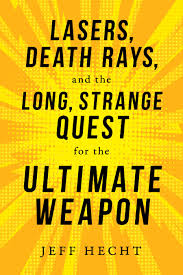The Strange History of Real-World Laser Weapons: Q&A with Author Jeff Hecht

Lasers. A staple in science fiction for decades upon decades, they have appeared as ray guns, phasers, lightsabers and much more. But lasers, and even laser weapons, aren't restricted to sci-fi.
In his latest book, "Lasers, Death Rays, and the Long, Strange Quest for the Ultimate Weapon," (Prometheus Books, 2019), released Jan. 8, Jeff Hecht, an award-winning veteran science writer, details the incredible history of real-life laser weapons.
Because adding lasers to any plan makes it seem infinitely more exciting, laser weapon inventions have ranged from the wildly improbable "death ray" to giant lasers the size of a Boeing 747 airplane. Hecht expertly captures the history of laser weapons while, at the same time, reflecting on their sci-fi influences. [How 'Star Trek' Technology Works (Infographic)]
Space.com spoke with Hecht about the dramatic history of laser weapons and what separates science fiction from reality.
Space.com: What inspired this book?
Jeff Hecht: Well, it's inspired by having been thinking about and covering laser weapons for a long time and now seeing that ... new technology has come along that makes the idea of laser weapons a lot more plausible for a limited range of applications. In particular, we're now talking about lasers that can run on electric power, which is pretty much what the military wants on a battlefield.

Space.com: What is the biggest misconception about lasers?
Get the Space.com Newsletter
Breaking space news, the latest updates on rocket launches, skywatching events and more!
Hecht: Well, I think [misconceptions come] from watching too many movies and episodes of "Star Trek" where you think you just point the laser beam at it or the weapon at something and it disintegrates or is zapped instantly at the speed of light without any consequences. A gun recoils, [and a laser weapon would, too]. It's also one of the things that people tend to think … you can have these little handheld weapons where really you'd need something much more substantial. The new laser weapons are much more compact but they're still basically an industrial laser, a customized industrial laser. It's not a handheld weapon. At best it's something that's more like a bazooka ... and, actually, that's probably an underestimate of what the size is.
Space.com: Are laser weapons a realistic part of our future?
Hecht: I think they may be a niche weapon and for special combat situations, and I would think — this is most likely right now — what we're worried about is insurgent weapons, drones or rockets. What you have now, what the conventional weapon has been, is something like a Patriot missile [a missile launched to collide with and take out an enemy missile in mid-air] to take out these rockets.
I don't think this is something that's going to be standard weapon in the near term, although there's more ambitious projects they're talking about. There's a lot of politics involved in getting it to that stage.
The giggle factor is gone, but it's getting more down to a practical case of will this work on the battlefield and is it something that you can deploy [that's] not going to be knocked out of commission by a little dirt getting in the works. There's a lot of issues in getting there but it looks more plausible [with recent developments in] the industrial solid-state laser and the fiber laser.
Space.com: Why do you think people get so excited about lasers?
Hecht: Well, I think It's something that catches the imagination: the beam of light and the idea that you can cut things with it. And some of that comes from science fiction. Some of that came from the early days [when] the laser was new and nobody really knew what its limits were.
DARPA [the Defense Advanced Research Projects Agency], which then was called ARPA, had a mission of trying to protect the U.S. against Soviet nuclear missile attack. And there really wasn't any good technology available to, what they at the time called, you had to "hit a bullet with a bullet," [which meant] you had to hit a very fast rocket with another very fast rocket.
It does have a way of catching the imagination. People get attracted to this idea and it does seem magical, especially when the laser was new. It's still magical today; you see people playing with these little pockets lasers that are cat toys.
Space.com: Are there any lasers in science fiction that are close to reality?
Hecht: You know in some ways I would go back to the Martian heat ray of "The War of the Worlds" because the Martian heat ray is essentially a personal piece of artillery that each one of these tripods is walking around with … You get into a problem with science fiction [where] you want something that's handheld and really personal, and that takes it out of what's realistic.
If you take something like the "Star Trek" phaser where you can set it anywhere from stun to kill or vaporize, I haven't looked at them in great detail, there's nothing quite like that. It's more something that you would have on a ship or on a plane or on a jet or on a rocket, for that matter, that would be fairly substantial.
One of the other things that you don't see right now at least in most of the science fiction that I've seen recently … [in fiction] the laser kill is almost immediate, the beam focuses onto it and it blows up, where it takes seconds to deliver enough heat to kill a realistic target.
Space.com: What do you think will surprise people most about this book, and what do you hope they take away from it?
Hecht: Well, on one level, I think the identity of the MIT professor who debunked Nikola Tesla's death rays will be something of a surprise. [You'll have to read the book to find out who.]
What I hope they walk away with is an understanding of how technology really develops. That it really sometimes isn't a straight path, and it's not easy and it's not something magical that can give you a breakthrough next week that will change the world.
This interview was edited for length. You can buy "Lasers, Death Rays, and the Long, Strange Quest for the Ultimate Weapon," on Amazon.com.
Follow Chelsea Gohd on Twitter @chelsea_gohd. Follow us @Spacedotcom, Facebook and Google+. Original article on Space.com.
Join our Space Forums to keep talking space on the latest missions, night sky and more! And if you have a news tip, correction or comment, let us know at: community@space.com.

Chelsea “Foxanne” Gohd joined Space.com in 2018 and is now a Senior Writer, writing about everything from climate change to planetary science and human spaceflight in both articles and on-camera in videos. With a degree in Public Health and biological sciences, Chelsea has written and worked for institutions including the American Museum of Natural History, Scientific American, Discover Magazine Blog, Astronomy Magazine and Live Science. When not writing, editing or filming something space-y, Chelsea "Foxanne" Gohd is writing music and performing as Foxanne, even launching a song to space in 2021 with Inspiration4. You can follow her on Twitter @chelsea_gohd and @foxannemusic.









